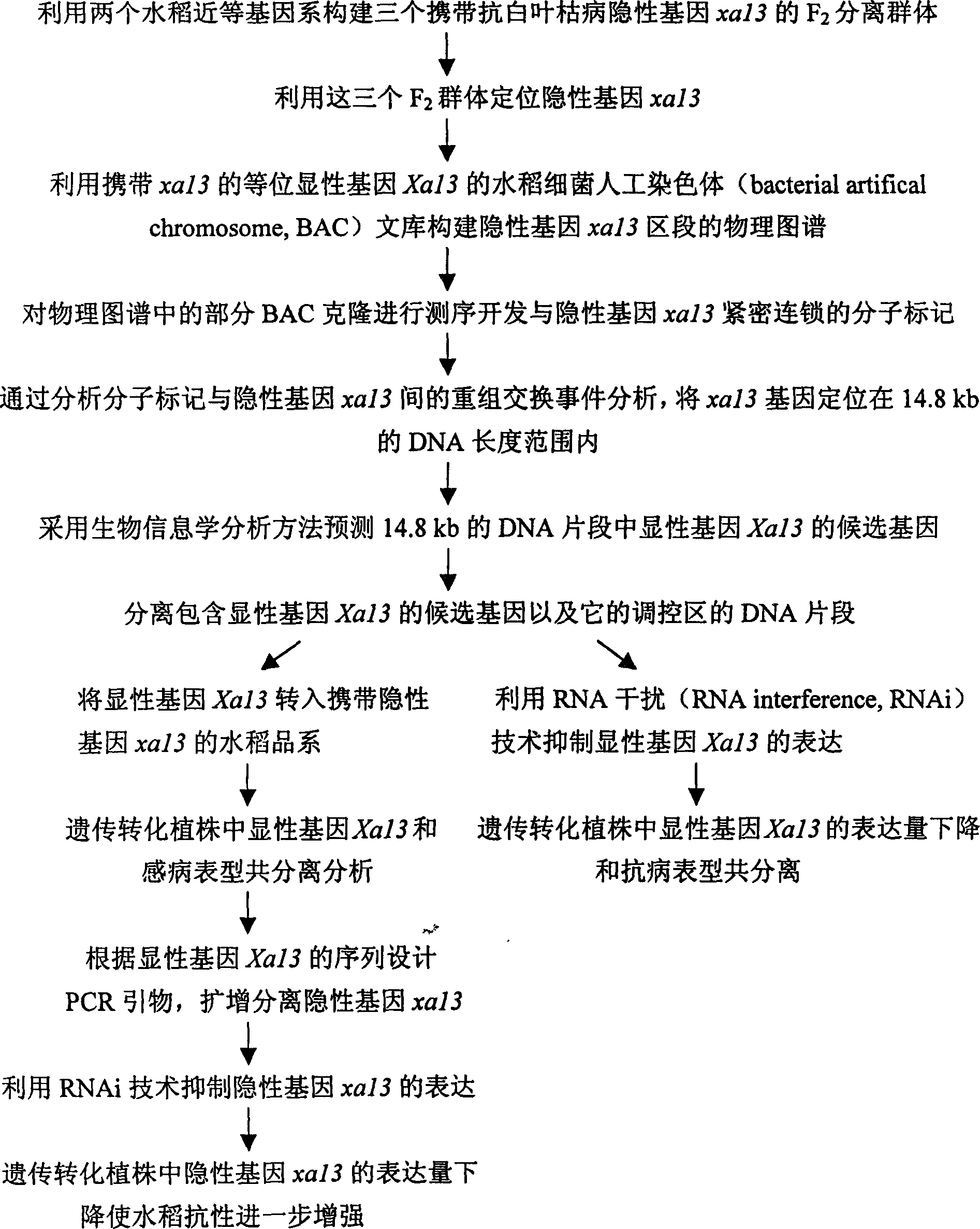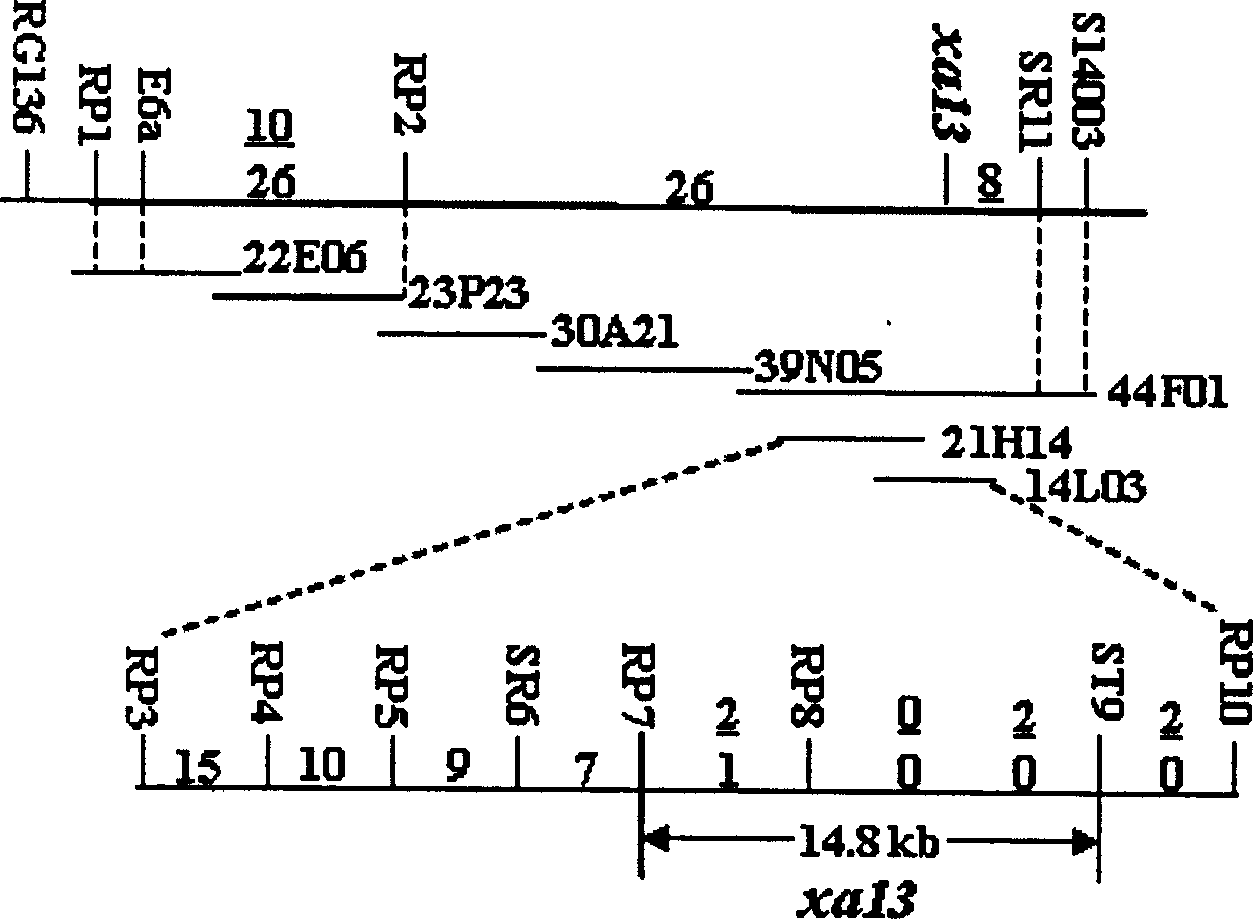Recessive gene xa13 of rice bacterial blight resistance and its allelic dominant gene xa13
A dominant gene and recessive gene technology, applied in the field of plant biology, can solve the problems of reduced germination rate and crispy rice.
- Summary
- Abstract
- Description
- Claims
- Application Information
AI Technical Summary
Problems solved by technology
Method used
Image
Examples
Embodiment 1
[0025] Example 1: Construction of a physical map of the xa13 segment of the recessive gene resistant to bacterial blight
[0026] 1. Experimental materials and inoculation methods
[0027] The indica rice line "IRBB13" carrying the recessive gene xa13 and the near-isogenic line of "IRBB13" (recurrent susceptible parent), "IR24" carrying the dominant gene Xa13 (Chu et al., 2004, Genome-wide analysis ofdefense-responsive genes in bacterial blight resistance of rice mediated by the recessive R genexa13.Mol.Genet.Genomics 271:111-120) constructed three F 2 group. The first population consisted of 250 extremely resistant (lesion length less than 3 cm two weeks after inoculation with bacterial blight PXO99) individual plants, the second population consisted of 6000 random individual plants, and the third population consisted of 1972 individual plants Composition of random individual plants. Use the three F's 2 Population mapping of the recessive gene xa13.
[0028] The present ...
Embodiment 2
[0036] Example 2: Fine-mapping the recessive gene xa13
[0037] Molecular marker E6a in the second F 2 Recombination with the xa13 site was detected in 26 individual plants of the population ( figure 2 ). The 26 recombinant exchange individuals detected with the E6a marker were further analyzed with a series of molecular markers from the sequenced BAC clones. These markers include 6 shotgun clones (RP3, RP4, RP5, RP7, RP8 and RP10) derived from BAC clones 21H14 and 14L03, the SSR (simple sequence repeat) marker SR6 designed based on the 21H14 sequence and the CAPS marker ST9 designed based on the 14L03 sequence . The analysis found that the markers RP3, RP4, RP5, SR6 and RP7 were detected to recombine with the xa13 locus in 1 to 15 of the 26 individual plants related to the E6a marker, while the markers RP8, ST9 and RP10 were detected in the 26 individual plants. All of the individual plants were co-segregated with the xa13 locus ( figure 2 ).
[0038] The SSR marker S...
Embodiment 3
[0039] Example 3: Isolation and functional verification of the dominant gene Xa13
[0040] 1. Determination of Xa13 candidate genes
[0041] Using GenScan ( http: / / genes.mit.edu / GENSCAN.html ) and Fgenesh (http: / / www.softberry.com / ) gene prediction software for molecular markers RP7 and ST9, including xa13 allele dominant gene Xa13, derived from rice variety IR64 14.8kb ( figure 2 ) sequence analysis, it was shown that there may be three genes in this segment. The first and third genes are incomplete and the second gene is complete. Therefore, it is speculated that the second gene is the dominant gene Xa13.
[0042] 2. Isolation and verification of Xa13 candidate genes
[0043] The present invention uses restriction endonuclease BamHI to digest the plasmid DNA of the BAC clone 14L03 of rice variety IR64, and isolates a candidate gene comprising the dominant gene Xa13, a DNA fragment about 14 kb in length ( image 3 ). The Agrobacterium-mediated genetic transformation v...
PUM
 Login to View More
Login to View More Abstract
Description
Claims
Application Information
 Login to View More
Login to View More - R&D
- Intellectual Property
- Life Sciences
- Materials
- Tech Scout
- Unparalleled Data Quality
- Higher Quality Content
- 60% Fewer Hallucinations
Browse by: Latest US Patents, China's latest patents, Technical Efficacy Thesaurus, Application Domain, Technology Topic, Popular Technical Reports.
© 2025 PatSnap. All rights reserved.Legal|Privacy policy|Modern Slavery Act Transparency Statement|Sitemap|About US| Contact US: help@patsnap.com



